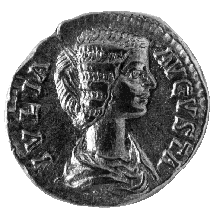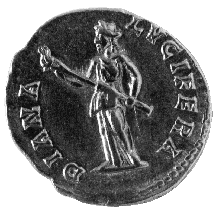



(113) Septimius Severus - AV aureus, A.D. 196, 7.12 g. (inv. 91.200).
Obverse: Draped bust of Julia Domna r.; IVLIA AVGVSTA: Julia Augusta.
Reverse: Diana Lucifera standing l., holding torch; DIANA LVCIFERA: Diana
Lucifera.
Provenance: Bank Leu, 1972.
Bibliography: H. Mattingly and E.A. Sydenham, The Roman Imperial Coinage
IV.1: Pertinax to Geta (London 1936) 548.
Julia Domna, the daughter of the high priest of the Sun at Emesa in Syria,
married Septimius Severus in about A.D. 185, while he was a governor in
Gaul. Severus, a notoriously superstitious man, chose her on the basis of
her horoscope, which predicted that she would marry a king. Julia Domna
had two sons, Antoninus (Caracalla) and Geta, who would eventually attain
the rank of Augustus, and two daughters. She was something of an intellectual
who had philosophers among her circle at court. She also travelled with
her husband on his campaigns and received unusual honors as empress. Like
Faustina the Younger (see no. 105), she was given the title Mater Castrorum,
Mother of the Camps. To this were added the unprecedented titles Mater
Senatus and Mater Patriae, Mother of the Senate and Mother of
the Country.
After the death of Severus, Julia Domna continued to receive honors from
her sons, and even after Antoninus had his younger brother murdered in her
arms, she continued to support him, accompanying him on his last campaign
to the East. After Antoninus was assassinated, she committed suicide in
A.D. 217. She was deified by her great-nephew, Elagabalus.
Julia Domna's portraits are noted for her distinctive hairstyle, a mass
of hair falling in waves from its central part, then caught in a braided
bun at the back; the hair is so heavy and stiff that it is likely to have
been a wig. On the reverse of this coin she is associated with Diana Lucifera,
the moon goddess and bearer of light.
K.L.M.



All contents copyright (c) 1996.
Lawrence University
All rights reserved.